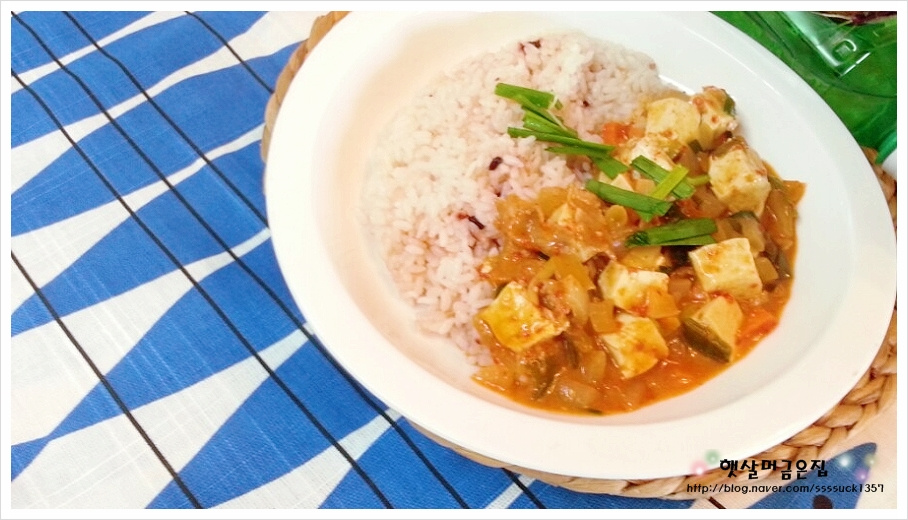Flavorful Mapo Tofu Without Doubanjiang
Easy Homemade Mapo Tofu Rice Bowl Recipe (No Doubanjiang Needed!)

Introducing a delicious Mapo Tofu Rice Bowl, perfect for rainy days or when you lack appetite. You can achieve a deep and rich flavor profile using doenjang and gochujang, even without doubanjiang. With easy-to-follow, step-by-step instructions, anyone can create a wonderful Mapo Tofu Rice Bowl. Make a satisfying meal that the whole family will love, right now!
Main Ingredients- 1/2 block firm tofu
- 1 handful of chives
- 1/2 onion
- 1/4 carrot
- 100g ground pork
Cooking Instructions
Step 1
Hello everyone! Today, I’m sharing a recipe for Mapo Tofu Rice Bowl that is incredibly delicious, even without using doubanjiang. It’s so flavorful that you won’t need any other side dishes; just spoon it over hot rice, whether it’s leftover or freshly cooked, and mix it all up for a fantastic meal. It’s especially perfect on a rainy day! Shall we start with this golden recipe for Mapo Tofu Rice Bowl that anyone can easily follow?

Step 2
First, let’s prepare the tofu. Cut the tofu into approximately 1.5 cm cubes (diced). Bring a pot of water to a boil, gently place the cubed tofu in it, and blanch for about 1 minute. Then, drain the tofu thoroughly using a sieve. Blanching the tofu makes it firmer, prevents it from breaking apart during cooking, and removes impurities for a cleaner taste.

Step 3
While the tofu is blanching, prepare the other ingredients. Finely dice the onion, and chop the carrot into similar-sized small pieces. Wash and cut the chives into 3 cm lengths. We’ll be using pre-ground pork for convenience.

Step 4
Now, let’s make the Mapo Tofu sauce! Heat a generous amount of cooking oil in a pan over medium-low heat. Add the chopped green onions (not listed in the ingredients, but for making scallion oil) and slowly sauté until the fragrance of the scallions is fully released, creating scallion oil. Utilizing Baek Jong-won’s method for making scallion oil is great. This adds a much deeper and more delicious flavor to the Mapo Tofu. There’s a noticeable difference in taste with and without this aromatic base.

Step 5
Once the scallions turn golden brown and release a fragrant aroma, reduce the heat to low and add the gochugaru (chili flakes). Stir quickly to infuse the oil with chili essence, creating chili oil. It’s crucial to maintain low heat to prevent the chili flakes from burning! This homemade chili oil not only looks appealing but also significantly enhances the spicy flavor and aroma of the Mapo Tofu.

Step 6
After creating the flavorful chili oil, add the finely diced onion and carrot to the pan and stir-fry them together. Sauté until the vegetables become slightly translucent. You’ll notice a wonderful aroma filling the air. This dish is perfect for a Friday night meal (‘Bulgeum’ in Korean)!

Step 7
Next, add the ground pork. If you are using pork in larger pieces, it’s best to add it before the vegetables and cook it thoroughly. Since I’m using ground pork, I added it along with the vegetables. Break up the pork as it cooks and stir-fry it with the vegetables until it’s fully cooked through.

Step 8
Now it’s time for the key seasonings for the Mapo Tofu sauce. While doubanjiang is ideal, don’t worry if you don’t have it! Adding a little doenjang (fermented soybean paste) can create a similar umami flavor. Add 1 tsp doenjang, 1 tsp gochujang (Korean chili paste), 1 tsp soy sauce, 1/2 tsp sugar, and 1 tsp sesame oil to the pan. Mix well. Then, pour in a little water (about 1/2 cup) and bring it to a simmer to allow the flavors to meld. Once it starts to boil, taste and adjust seasoning with salt or more soy sauce if needed.

Step 9
Once the sauce has simmered and the flavors have blended, it’s time to thicken it. Gradually add the starch slurry (30g starch mixed with 2-3 Tbsp water) while stirring continuously. Don’t add all the starch mixture at once; gradually add it and stir until you achieve your desired consistency. Be careful not to make it too thick.

Step 10
This is the final step! Gently add the blanched and drained tofu cubes into the sauce. Carefully stir to coat the tofu with the sauce. Be gentle to avoid breaking the tofu. Finally, sprinkle a pinch of black pepper for an extra boost of flavor. The completed Mapo Tofu is a hit with both children and adults, making it perfect for times when you’re not feeling very hungry. Isn’t it incredibly simple to make?

Step 11
Isn’t it amazing that you can make such delicious Mapo Tofu Rice Bowl without doubanjiang? With this recipe, anyone, young or old, can easily and deliciously create Mapo Tofu Rice Bowl. Enjoy a wonderful and satisfying meal with this delightful Mapo Tofu Rice Bowl tonight!




